Eucla and the Telegraph Office.
- Home, index, site details
- Australia 1901-1988
- New South Wales
- Overview of NSW
- Telegraph lines
- Telegraph Offices
- Date stamps
- Forms
- Envelopes
- Rates
- Stamps
- Queensland
- Overview of Qld
- Telegraph lines
- Telegraph offices
- Date stamps
- Forms
- Envelopes
- Rates
- Stamps
- South Australia
- Overview of SA
- Telegraph lines
- Telegraph Offices
- Date stamps
- Forms
- Envelopes
- Rates
- Stamps
- Tasmania
- Overview of Tasmania
- General developments
- Reports
- Organisation
- Telegraph lines
- Telegraph Offices
- Date stamps
- Railway lines
- Forms
- Envelopes
- Rates
- Stamps
- Overview of Tasmania
- Victoria
- Overview of Vic.
- Telegraph lines
- Telegraph offices
- Date stamps
- Forms
- Envelopes
- Rates
- Stamps
- Ephemera
- Western Australia
- Overview of WA
- Telegraph lines
- Telegraph Offices
- Date stamps
- Forms
- Envelopes
- Rates
- Stamps
The Eucla Telegraph Station is remembered through the following sections:
- the geographical location of Eucla.
- the buildings at the Telegraph Station;
- the inside room of the Station;
- the staff and the families at the Telegraph Station;
- aspects of the work outside;
- features in the area surrounding the Telegraph Station.
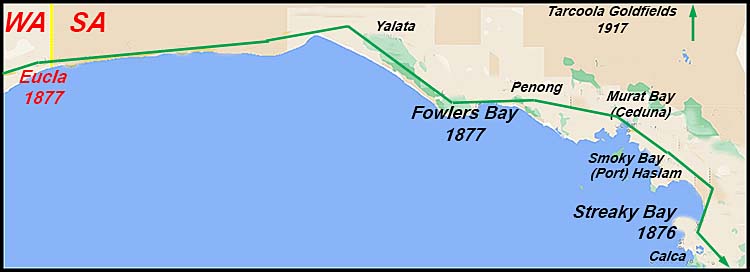 |
| Eucla is 4-5 miles on the western side of the Western Australia - South Australia border.
For those who have not been there for some time, it is important to reiterate that Eucla is at the centre of everything (as the signpost indicates). The Telegraph Station opened on 8 December 1877. Its status changed to a Post & Telegraph Office in 1895. No special date stamp has been recorded for use with telegrams at Eucla.
|
 |
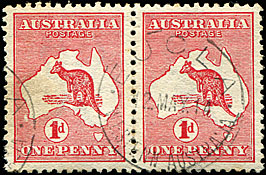 Usual postal date stamp. 12 May 1913. |
The Eucla Telegraph Station was the largest station on the 1877 East-West Telegraph line It acted as a transfer point for telegraphic messages between South Australia and Western Australia from 1896 to 1905 at which time the operations were amalgamated under the Western Australian Post and Telegraph Department.
The weatherboard station erected at Eucla in 1876 served its purpose for twenty years.Then, to meet the needs of the enlarged staff and equipment due to the gold discoveries and increasing trade, a fine stone building together with separate stone quarters were built at a cost of about £6000.
A substantial jetty, running out into five fathoms of water, was completed in 1887, by Contractor Wishart, under the direction of Public Works Superintendent Fairgrieve.
On 28 June 1898, the West Australian published the following report:
"Concerning the erection of the new Eucla Telegraph Station, Mr. M. E. Jull, the Under-Secretary for Works, has received a report from the Superintendent of Public Buildings to the effect that the work has been executed in a satisfactory manner. The contract price was £6,334 16s. 9d., and extras were decided upon to the extent of £210 17s. 6d., bringing the total cost up to £6,545 14s. 3d. The contract was accepted on October l8 last year and handed over to Mr. Stevens, the manager of the Telegraph Department, as completed on March 21 last. The undertaking occupied 22 weeks longer than the time stipulated in the contract, so that the amount which had to be forfeited by the contractor as penalties at the rate of £7 per week was £154. It was pointed out in the Report that the principal cause of the delay, as stated by the contractor, was his inability to get a steamer to convey material for the work from Fremantle. In the same Report the Superintendent also stated that the repairs commenced some little time ago in connection with the old Eucla Telegraph Station had been completed at a cost of £391 2s. 4d, and that the additions to what was mentioned as the " Third Old Station" had been finished at a cost of £399 16s. l0d. The officers of the Telegraph Department stationed at Eucla, the Report concluded, were greatly pleased with the increased accommodation provided".
In 1898 South Australia maintained a Stationmaster, 11 operators and one linesman at Eucla. In addition, the Government electrician (Mr. Unbehaun) was dispatched to Eucla to superintend the removal of the instruments to the new Office.
A quadruplex instrument was placed by Todd on the Adelaide line via Yardea to Eucla with automatic quadruplex repeaters at Yardea. The line via Port Lincoln was still duplex.
A really wonderful first hand account of Eucla and life at the station is provided by Frederick G. Simmons in the Adelaide Mail of 4 August 1945.
 The Eucla Telegraph station and other buildings 1905. Source: Museum of South Australia B54057_5. |
|
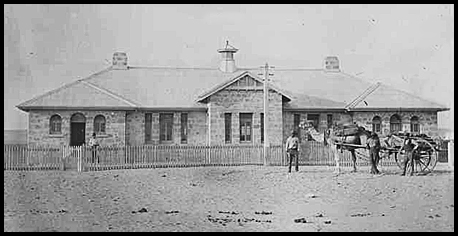 The Eucla Telegraph Station about 1905. Source: Museum of South Australia B54057-1. |
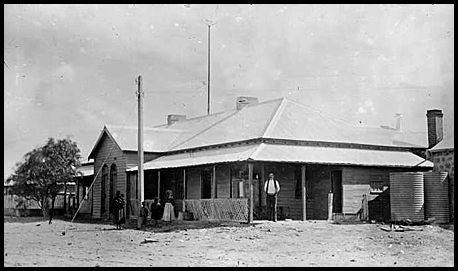 The Registrars Office at the Telegraph Station 1902. Source: Museum of South Australia B54057. |
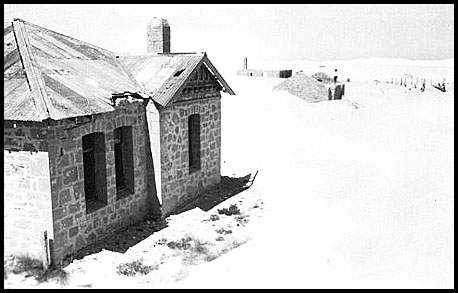 The Eucla Telegraph Station about 1956. |
 The Telegraph Station about 1980 - overcome by sand dunes. Photograph by Yewenyi. |
 Inside the Telegraph Office - dividing partition down the middle of the desks so that Western Australian operators sat on the western side and the South Australian operators sat on the eastern side. The holes in the dividing partition enabled the operators of one Colony to pass messages to those from the other Colony for retransmission. Inside the Telegraph Office - dividing partition down the middle of the desks so that Western Australian operators sat on the western side and the South Australian operators sat on the eastern side. The holes in the dividing partition enabled the operators of one Colony to pass messages to those from the other Colony for retransmission.
Provenence: Gundersen, Johnstone. |
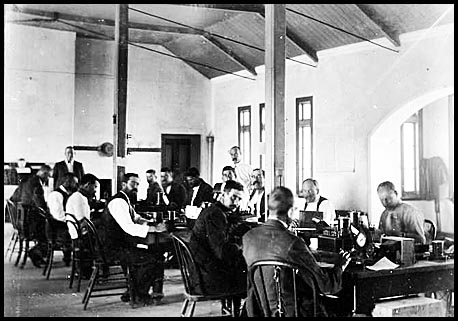 Inside the Telegraph Office - dividing wall taken down after the realisation of the room having the same time zone. Source: National Library of South Australia B54060-12. |
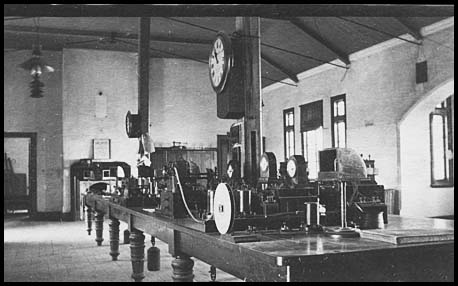 The operating room housed three sets of automated repeaters. The operating room housed three sets of automated repeaters.The large roll of paper tape for recording messages for one machine can be seen under the clock. Provenance: Johnstone. |
|
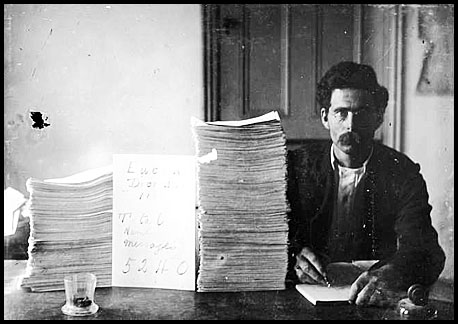 Staff member (probably Albert Lionel Clayer) with a sign next to him summarising the messages. The sign reads: "EUCLA direct SA 1905 T to C Number of messages 5,240. Source: Library of South Australia B54060-13. |
 The staff at the Telegraph Office in 1898. Source: National Library of South Australia B35784. |
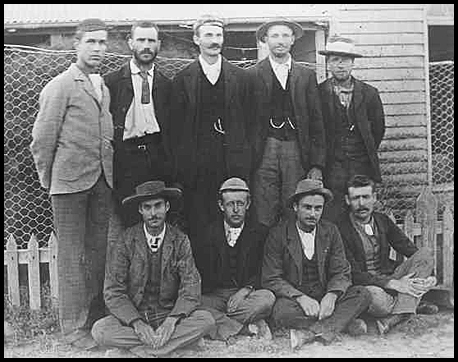 The South Australian staff at the Telegraph Office in 1905. Source: National Library of South Australia B35782. |
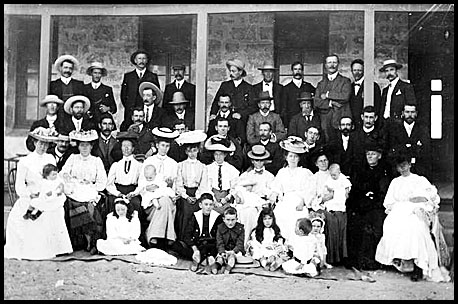 Residents of the Eucla Telegraph Office in 1905. Source: State Library of South Australia B54060-8. |
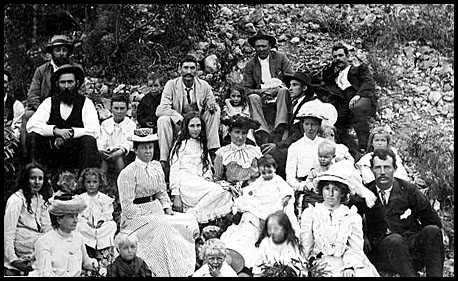 Telegraph Office families picnicing near Eucla in 1905. Source: State Library of South Australia B54060-33. |
 Women and children at Eucla. Source: State Library of South Australia B54060-27. |
|
 A family picnic. Source: State Library of South Australia B54060-29. |
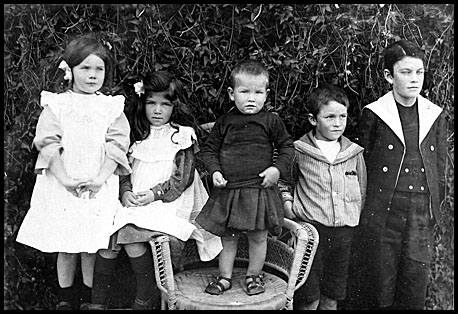 The Groper family in Eucla about 1905. Source: State Library of South Australia B54060-26. |
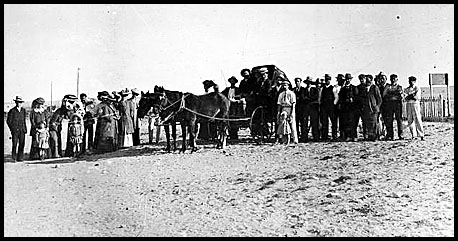 A family setting out for Adelaide. Source: State Library of South Australia B54060-63. |
Aspects of the life outside the Telegraph Office.
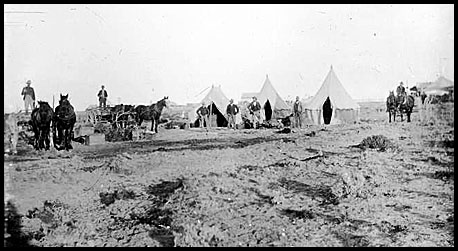 South Australian workers at a camp on the outskirts of Eucla. Source: State Library of South Australia B54060-11. |
 South Australian line workers moving camp. Source: State Library of South Australia B54060 - 10. |
 The Eucla tennis courts. Source: State Library of South Australia B54060-60. |
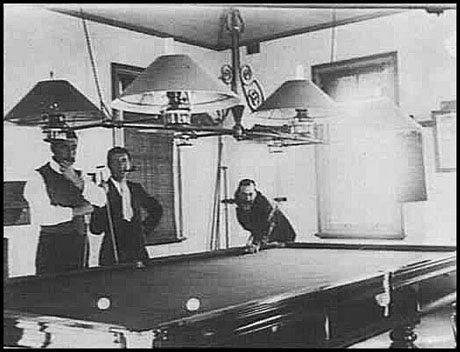 Staff billiards about 1907. Source: State Library of South Australia - B49181. |
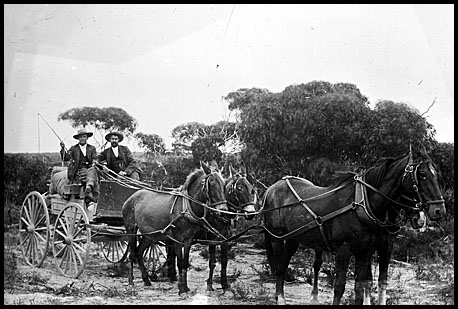 Mail being sent to Fowlers Bay in South Australia. Source: State Library of South Australia B54060-15. |
|
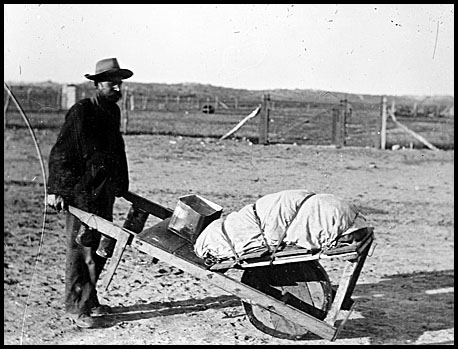 A swagman with his barrow and possessions passing by Eucla on his journey through the desert. Source: State Library of South Australia B54060-40. |
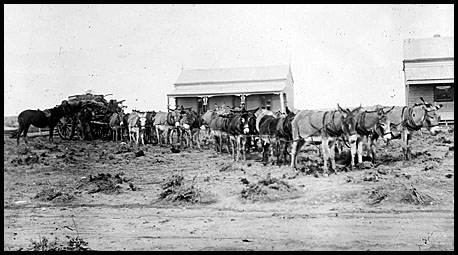 A large donkey train pulling a wagon and passing through Eucla. Source: State Library of South Australia B54060-24. |
 A large camel supply team arriving at Eucla about 1905. Source: State Library of South Australia B54060-22. |
Features in the area surrounding the Telegraph Station.
The monument at Eucla erected in July 1958. Erected C. W. Davidson, Postmaster General The establishment of the |
 |
Thanks to the State Library of South Australia for assembling a 101 photograph collection and making it available to the public on the internet in an easy-to-access format.

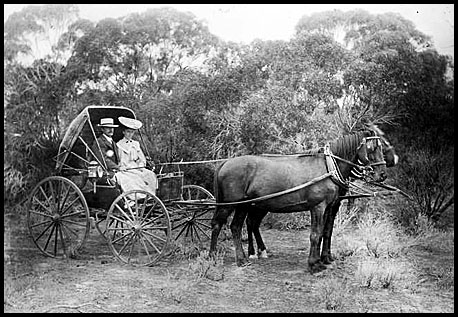
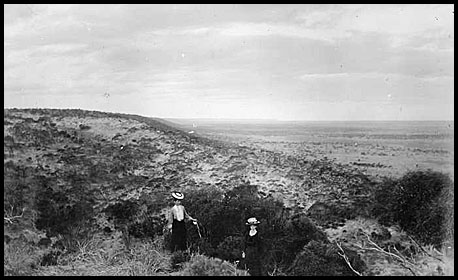
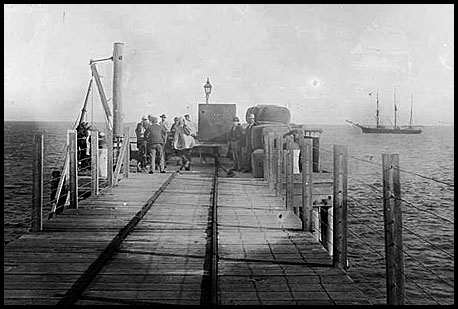

.jpg) Wilson's Bluff on the South Australia-Western Australia border and looking towards South Australia.
Wilson's Bluff on the South Australia-Western Australia border and looking towards South Australia.